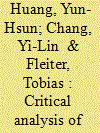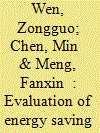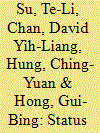|
|
|
Sort Order |
|
|
|
Items / Page
|
|
|
|
|
|
|
| Srl | Item |
| 1 |
ID:
149964


|
|
|
|
|
| Summary/Abstract |
The cement industry is the second most energy-intensive sector in Taiwan, which underlines the need to understand its potential for energy efficiency improvement. A bottom-up model-based assessment is utilized to conduct a scenario analysis of energy saving opportunities up to the year 2035. The analysis is supported by detailed expert interviews in all cement plants of Taiwan. The simulation results reveal that by 2035, eighteen energy efficient technologies could result in 25% savings for electricity and 9% savings for fuels under the technical diffusion scenario. This potential totally amounts to about 5000 TJ/year, of which 91% can be implemented cost-effectively assuming a discount rate of 10%. Policy makers should support a fast diffusion of these technologies. Additionally, policy makers can tap further saving potentials. First, by decreasing the clinker share, which is currently regulated to a minimum of 95%. Second, by extending the prohibition to build new cement plants by allowing for replacement of existing capacity with new innovative plants in the coming years. Third, by supporting the use of alternative fuels, which is currently still a niche in Taiwan.
|
|
|
|
|
|
|
|
|
|
|
|
|
|
|
|
| 2 |
ID:
121364


|
|
|
|
|
| Publication |
2013.
|
| Summary/Abstract |
China's annual cement production (i.e., 1868 Mt) in 2010 accounted for nearly half of the world's annual cement production in the same year. We identified and analyzed 23 energy efficiency technologies and measures applicable to the processes in China's cement industry. The Conservation Supply Curve (CSC) used in this study is an analytical tool that captures both the engineering and the economic perspectives of energy conservation. Using bottom-up CSC models, the cumulative cost-effective and technical electricity and fuel savings, as well as the CO2 emission reduction potentials for the Chinese cement industry for 2010-2030 are estimated. By comparison, the total final energy saving achieved by the implementation of these 23 efficiency measures in the Chinese cement industry over 20 years (2010-2030) is equal to 30% of the total primary energy supply of Latin America or Middle East or around 71% of primary energy supply of Brazil in 2007. In addition, a sensitivity analysis with respect to the discount rate is conducted to assess its effect on the results. The result of this study gives a comprehensive and easy to understand perspective to the Chinese cement industry and policy makers about the energy efficiency potential and its associated cost.
|
|
|
|
|
|
|
|
|
|
|
|
|
|
|
|
| 3 |
ID:
121353


|
|
|
|
|
| Publication |
2013.
|
| Summary/Abstract |
In 2010, China's cement output was 1.9 Gt, which accounted for 56% of world cement production. Total carbon dioxide (CO2) emissions from Chinese cement production could therefore exceed 1.2 Gt. The magnitude of emissions from this single industrial sector in one country underscores the need to understand the uncertainty of current estimates of cement emissions in China. This paper compares several methodologies for calculating CO2 emissions from cement production, including the three main components of emissions: direct emissions from the calcination process for clinker production, direct emissions from fossil fuel combustion and indirect emissions from electricity consumption. This paper examines in detail the differences between common methodologies for each emission component, and considers their effect on total emissions. We then evaluate the overall level of uncertainty implied by the differences among methodologies according to recommendations of the Joint Committee for Guides in Metrology. We find a relative uncertainty in China's cement-related emissions in the range of 10 to 18%. This result highlights the importance of understanding and refining methods of estimating emissions in this important industrial sector.
|
|
|
|
|
|
|
|
|
|
|
|
|
|
|
|
| 4 |
ID:
137702


|
|
|
|
|
| Summary/Abstract |
Much of China's cement industry still uses outdated kilns and other inefficient technologies, which are obstacles to improving energy efficiency. Huge improvements in energy consumption intensity can be made by improving this technology. To evaluate the potential for energy-saving and CO2 emissions reduction in China's cement industry between 2010 and 2020, a model was developed based on the Asian-Pacific Integrated Model (AIM). Three scenarios (S1, S2 and S3) were developed to describe future technology policy measures in relation to the development of the cement industry. Results show that scenario S3 would realize the potential for CO2 emissions mitigation of 361.0 million tons, accounting for 25.24% of the predicted emissions, with an additional energy saving potential of 39.0 million tons of coal equivalent by 2020. Technology promotion and industrial structure adjustment are the main measures that can lead to energy savings. Structural adjustment is the most important approach to reduce the CO2 emissions from the cement industry; the resulting potential for CO2 emissions reduction will be increasingly large, even exceeding 50% after 2016.
|
|
|
|
|
|
|
|
|
|
|
|
|
|
|
|
| 5 |
ID:
113486


|
|
|
|
|
| Publication |
2012.
|
| Summary/Abstract |
This study analyzes current energy and carbon dioxide (CO2) emission trends in China's cement industry as the basis for modeling different levels of cement production and rates of efficiency improvement and carbon reduction in 2011-2030. Three cement output projections are developed based on analyses of historical production and physical and macroeconomic drivers. For each of these three production projections, energy savings and CO2 emission reduction potentials are estimated in a best practice scenario and two continuous improvement scenarios relative to a frozen scenario. The results reveal the potential for cumulative final energy savings of 27.1 to 37.5 exajoules and energy-related direct emission reductions of 3.2 to 4.4 gigatonnes in 2011-2030 under the best practice scenarios. The continuous improvement scenarios produce cumulative final energy savings of 6.0 to 18.9 exajoules and reduce CO2 emissions by 1.0 to 2.4 gigatonnes. This analysis highlights that increasing energy efficiency is the most important policy measure for reducing the cement industry's energy and emissions intensity, given the current state of the industry and the unlikelihood of significant carbon capture and storage before 2030. In addition, policies to reduce total cement production offer the most direct way of reducing total energy consumption and CO2 emissions.
|
|
|
|
|
|
|
|
|
|
|
|
|
|
|
|
| 6 |
ID:
124372


|
|
|
|
|
| Publication |
2013.
|
| Summary/Abstract |
The cement industry represents one of the most energy intensive sectors in Taiwan. Energy audits are the direct tools which are employed to help reduce energy consumption. The objectives of energy audits are to establish energy audit systems, provide on-site energy audit service and reduce production cost. This study summarized the energy savings implemented in Taiwan's cement industry; the data were obtained from the on-line Energy Declaration System in 2010. The total implemented energy savings amounted to 68,512 kilo liter of crude oil equivalent (KLOE). The energy audit group audited seven Taiwanese cement plants in 2011 and revealed an energy saving potential of 2571.6 MWh of electricity and 1002.8 KLOE of thermal energy. The total potential energy saving was 1708.5 KL of crude oil equivalent (KLOE), equivalent to a 4560 t reduction in CO2 emissions, representing the annual CO2 absorption capacity of a 122 ha forest plantation.
|
|
|
|
|
|
|
|
|
|
|
|
|
|
|
|
| 7 |
ID:
122717


|
|
|
|
|
| Publication |
2013.
|
| Summary/Abstract |
Cement industry is one of the six energy intensive industries in Iran accounting for 15% of total energy consumption in the industrial sector. The sudden reform of energy prices in Iran is expected to have a great impact on production and energy consumption in this industry. In this paper, we present a system dynamics model to analyze energy consumption and CO2 emission in Iranian cement industry under various production and export scenarios. We consider new energy prices to estimate possible energy demand by this industry over next 20 years. The model includes demand for cement, production, energy consumption and CO2 emission in an integrated framework with emphasis on direct natural gas consumption. Producing blended cement, production using waste materials as alternative fuel, and wasted heat recovery for electricity generation in cement industry are three main corrective policies simulated and discussed herein. Simulation result show that complete removal of energy subsidy and implementation of corrective policies in the cement industry could potentially lead to reductions of 29% and 21%, respectively in natural gas and electricity consumptions and 22% reduction in CO2 emission.
|
|
|
|
|
|
|
|
|
|
|
|
|
|
|
|
| 8 |
ID:
093515


|
|
|
|
|
| Publication |
2010.
|
| Summary/Abstract |
The cement industry is one of the largest energy-consuming industries in Thailand with high carbon dioxide (CO2) emissions. Using a bottom-up electricity Conservation Supply Curve (CSC) model, the cost effective and the total technical electricity-efficiency potential for the Thai cement industry in 2008 is estimated to be about 265 and 1697 gigawatt-hours (GWh) which account for 8% and 51% of the total electricity used in the cement industry in 2005, respectively. The fuel CSC model shows the cost-effective fuel-efficiency potential to be 17,214 terajoules (TJ) and the total technical fuel-efficiency potential equal to 21,202 TJ, accounting for 16% and 19% of the total fuel used in cement industry in 2005, respectively. The economic analysis in this paper shows how the information from the CSCs can be used to calculate the present value (PV) of net cost savings over a period of time taking into account the energy price escalation rate. The results from the policy scenario analysis show that the most effective and efficient policy scenario is the introduction of an energy-related CO2 tax for the cement industry under a voluntary agreement program. This scenario results in 16.9% primary energy-efficiency improvement over a 5-year implementation period.
|
|
|
|
|
|
|
|
|
|
|
|
|
|
|
|
|
|
|
|
|